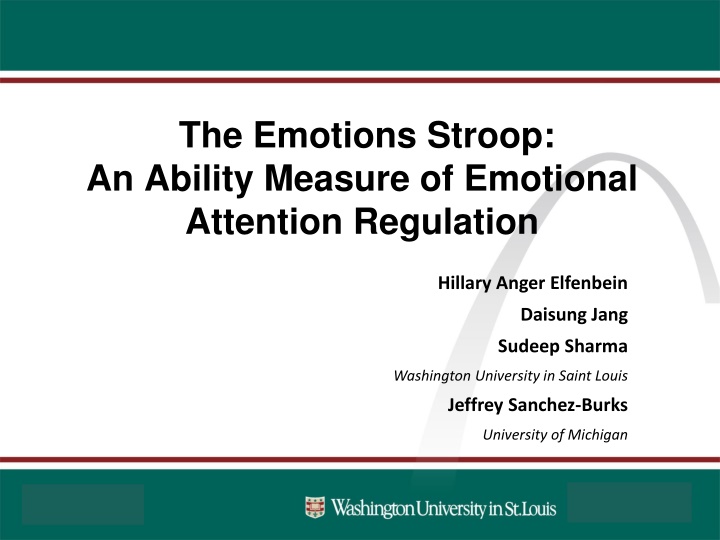
Innovative Measures for Emotional Attention Regulation Studies
Explore cutting-edge tools like the Emotions Stroop test and new measures of Emotional Intelligence (EI) to study emotional attention regulation. Discover how these methods enhance understanding of emotion processing and regulation.
Download Presentation

Please find below an Image/Link to download the presentation.
The content on the website is provided AS IS for your information and personal use only. It may not be sold, licensed, or shared on other websites without obtaining consent from the author. If you encounter any issues during the download, it is possible that the publisher has removed the file from their server.
You are allowed to download the files provided on this website for personal or commercial use, subject to the condition that they are used lawfully. All files are the property of their respective owners.
The content on the website is provided AS IS for your information and personal use only. It may not be sold, licensed, or shared on other websites without obtaining consent from the author.
E N D
Presentation Transcript
The Emotions Stroop: An Ability Measure of Emotional Attention Regulation Hillary Anger Elfenbein Daisung Jang Sudeep Sharma Washington University in Saint Louis Jeffrey Sanchez-Burks University of Michigan
Need to Develop New Measures of EI Trait-based (mixed-model) measures of EI are confounded, fakeable, and conceptually muddled (Roberts, MacCann, Matthews, & Zeidner, 2010) The dominant ability-based measures suffer from issues with consensus scoring Consensus is not synonymous with correct Consensus scoring does not allow detection of emotional genius!
Emotion Attention Regulation Regulating attention to emotion-laden stimuli Tuning in: Can you tune into nonverbal cues of emotion when other stimuli distract you? Tuning out: Can you avoid the influence of nonverbal cues of emotion when they are distracting you from the task at hand? Conceptually distinct, but we found were correlated Similar but not identical to emotion regulation Not about adjusting your internal affective experience About paying attention to the affective landscape
Inspiration from the Stroop Effect Name the color of the ink BLUE RED GREEN BLUE RED GREEN A measure of attentional ability Difference in reaction times (RT) indicate ability to focus on relevant information and ignore distractions
Our Emotions Stroop Extending the Stroop into emotion ability Present pairs of affect cues that potentially distract Visual and audio versions Audio positive/negative words in positive/negative vocal tones (POSITIVE vs. NEGATIVE): valence Visual happy/angry faces in green/red color (STOP vs. GO): approach-avoidance Distinct from previous emotions Stroops They used emotion-stimuli paired with colors, not emotion as the medium itself
Turning Emotions On for Faces If the emotion is happy, click GO If the emotion is angry, click STOP
Turning Emotions Off for Faces If the color is green, click GO If the color is red, click STOP
Turning Emotions On for Voices If the vocal tone is positive, click POSITIVE If the vocal tone is negative, click NEGATIVE
Turning Emotions Off for Voices If the word is positive, click POSITIVE If the word is negative, click NEGATIVE
Scoring EAR Examined errors on incompatible responses Original Stroop test used reaction time Generally, cognitive psychology research on interference tasks finds better properties for analyzing errors on distracted trials Our results were consistent with this empirical observation
Study Design Study 1: Test for reliability Emotion Stroop twice, one week apart; one group double-length N=122, Age M=19.3, 55 female Life satisfaction & DANVA Big 5, life satisfaction, DANVA, mindfulness, Law-Wong-Song EI, and color-word Stroop Study 2: Test for validity Emotion Stroop once N=157, Age M=18.8, 82 female Study 3: Additional tests for validity MBA students took the Emotion Stroop once Assessments included EI battery, peer-rated EI, GMAT, Big 5
Promising Reliability Positive manifold across the 4 components i.e., tuning in and tuning out, faces and voices Average r=.20s Test-retest reliability at one week r=.62 Split-half reliability r=.64
Promising Validity Converges with many other EI measures Observer-rated EI (-.30) DANVA faces (-.26), STEM (-.20) Not DANVA voices (-.06), STEU (-.04), MSCEIT (.04) Self-reported EI slightly with WLEIS (-.11), not SREIS (.01) Converges with cognitive ability (-.20, small sample) Diverges from general processing speed (.00) Diverges from personality and trait affect Except neuroticism (.13), agreeableness (-.10), anxiety (.13) Predictive validity for subjective well-being (-.19) No consistent gender difference (-.22 to .10, M=.06)
